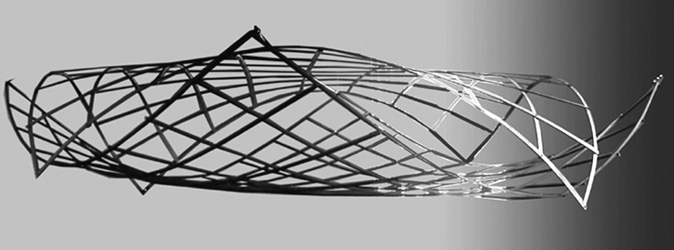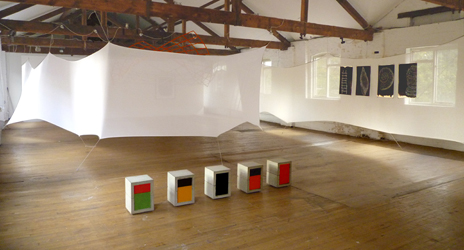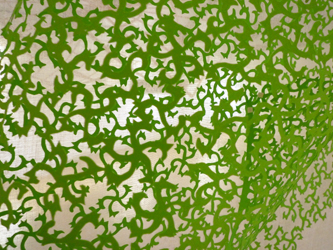|

"Gridshell Trellis",
plywood, paint, wire, 2.5m X 2.5m
Of words that have multiple and sometimes contradictory meanings, “compound” is a particularly fine example meaning both some thing formed by combining parts, elements, etc. and a building or buildings set off and enclosed by a barrier. The first definition is about adding, and may set off memories from childhood chemistry class of myriad molecules floating in space and coming together; whilst the second is about a barrier keeping those molecules at bay.
Our exhibition “Compound” explores this contradiction with a walled garden of man-made objects. It is a reference to Capability Brown landscapes, the statuary and stone platforms of Easter Island, Wolf Hilbertz’s “Strategies for Evolutionary
Environments” (1972) whose technology is now being used to re-build depleted coral reefs, and Dubai’s artificial Palm Islands, among others.
Modernists may uphold these man-made environments as the creative power of man, environmentalists may criticise them for hubris and environmental damage. Our aim is to explore this stasis, and ask how the consequences diverge, how the values inter-permeate, and how they are compounds.

![]()
On Wolf Hilbertz’s “Strategies for Evolutionary Environments”
In the 1970s, architect Wolf Hilbertz pioneered a technology to turn minerals in seawater into limestone, effectively making cement, or “sea-ment”. In short, the technology involved anchoring wire-mesh armatures in the sea, and connecting them to a supply of low-voltage electricity currents. Hilbertz’ dream was to grow an island, ecological and self-sustaining through fishing, deep-sea mineral harvesting and the export of the farmed limestone. Unfortunately the actual amount of electricity required to make sea-ment was far more expensive than for normal concrete.
Today, the technology is being re-introduced as “bio-rock”, and the focus is on coral propagation for the preservation and restoration of coral reefs, shore protection structures, and marine culture.

On Dubai's Palm Archipelago
The Palm Islands project consists in the creation of an archipelago of artificial peninsulas laid out in the shape of a palm tree.
The operation, which is in fact an act of land reclamation, is undertaken by spraying sand that is dredged from the bottom of the Persian Gulf. The tendency of the ocean to re-create its original configuration, levelling the shores until they completely disappear, means that a series of breakwater structures will be necessary to help maintain the new man-made layout.
 |
|
"Urban Invent", 3 of 3,
woodcut, white ink on white paint, sumi wash,
35 cm X 195 cm